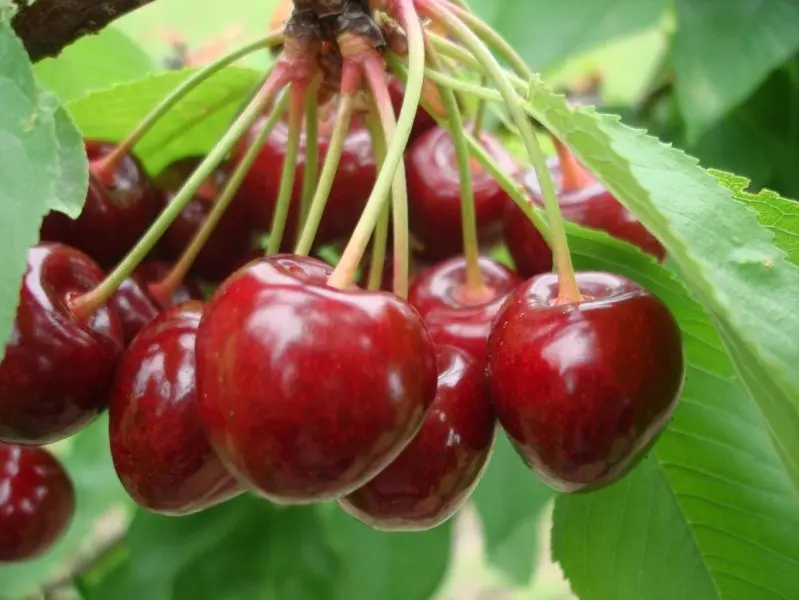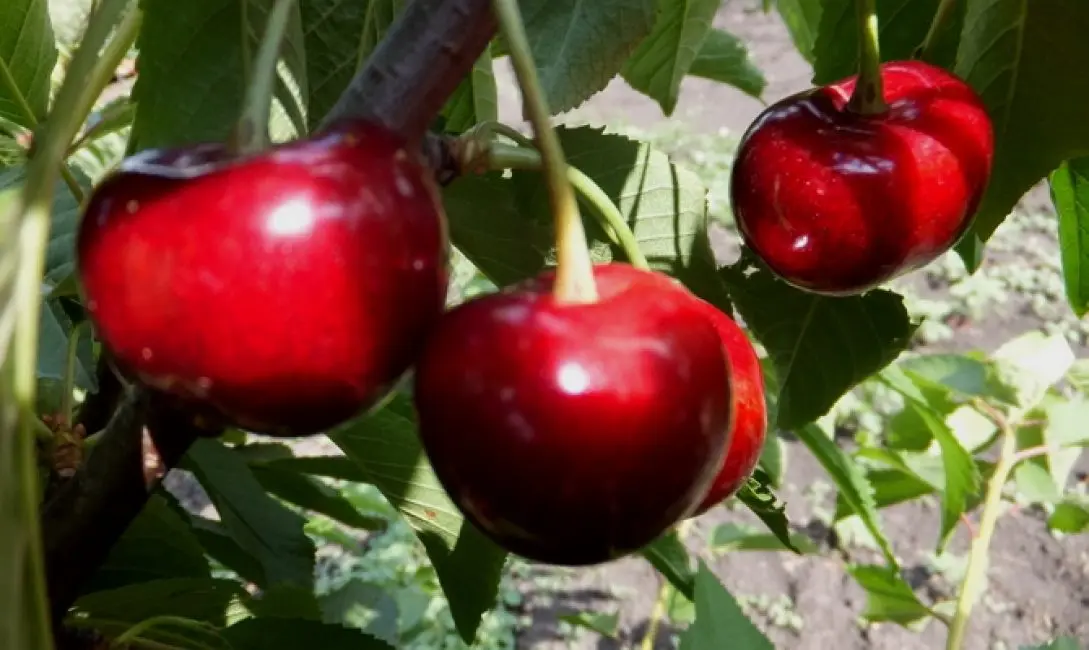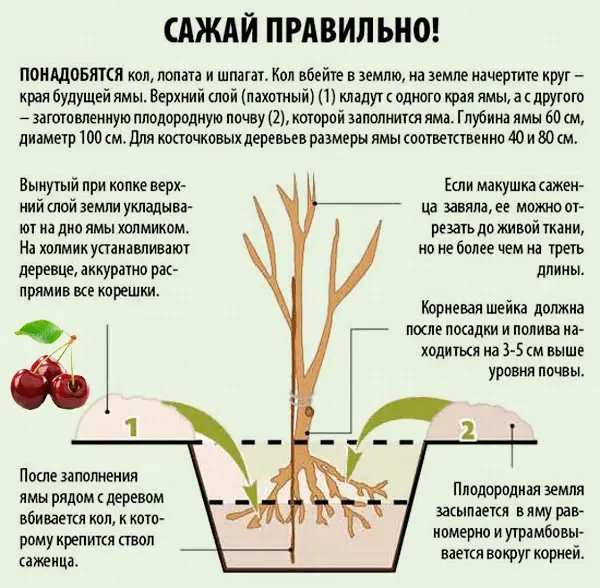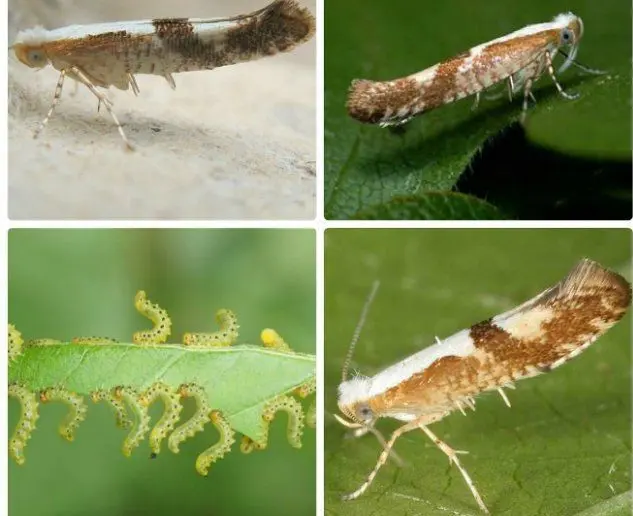Contents
Cherry Vasilisa is notable for its berries, one of the largest in the world selection. The fruits ripen in medium terms, the tree is hardy in frost and drought resistance. Delicious berries easily tolerate transportation.

History of breeding
The breeder of the experimental station in Artemovsk, Ukraine, L. I. Taranenko, by crossing the varieties Donetsk beauty and Donetsk coal, brought out the large-fruited sweet cherry Vasilisa in the early 2000s. After field tests, the variety became interested in the USA and Europe.
Description of the culture
Variety Vasilisa comes from plants that bear fruit in the southern lands. Many gardeners recommend not planting the Vasilisa variety above the latitude of Volgograd, so as not to be disappointed in the cherry as a species after damage to fruit buds in winter or after spring return frosts.
- A tree with an average growth force rises to 4 m, but with proper crown formation it will be lower, more convenient for picking fruits.
- The natural type of cherry crown Vasilisa is spherical.
- The branching is plentiful, the shoots are powerful, strong, with a brown light bark, slightly bent.
- The branches are leafy, but still the large berries of Vasilisa protrude from under the leaves.
- The leaf blade is ovoid, large, shiny, dark green.
- The flowers are white, often located directly on annual shoots.
- The rounded fruits of the Vasilisa variety are very large, fleshy, weigh 11–12 g, often 14 g. The skin is dense, glossy, saturated red. The juicy fragrant pulp has the same shade, which slightly crunches when eating. The berries are pleasant, sweet and sour, with a wine aftertaste and a rather large stone, which is easily separated.
- Cherry Vasilisa was rated by tasters at 4,5 points. Canned berries received the highest score – 4,8–5.
- Processed fruit juice remains bright red, does not darken. And the berries acquire a special sweetness and aroma.
Features
Before choosing a variety, gardeners study its properties in order to plant the one they like and the right one.
Drought resistance, frost resistance
Cherry Vasilisa tolerates winters well in its homeland. It is defined as more frost-resistant than the well-known variety Valery Chkalov, which withstands a long drop in temperature to -25 ° C. But spring frosts are detrimental to buds, flowers and ovaries.
Cherry Vasilisa is characterized by increased drought resistance, but regular watering will bring a greater yield and ensure abundant fruiting next year. The Vasilisa tree needs to be watered every 3-4 days with 10 liters of water, and in a drought the rate should be doubled.
Pollination, pollinating varieties, flowering period and ripening period
Variety Vasilisa, like most sweet cherries, is self-infertile. In the garden, it is necessary to plant 2-3 more trees of the same species with the same flowering time. Gardeners are advised to purchase the following varieties for cross-pollination to Vasilisa cherries:
- Valery Chkalov;
- Bigarro early;
- Melitopol early;
- Starking;
- Annushka;
- Burlat;
- Drogana is yellow.
Variety Vasilisa blooms in April – early May. In the conditions of the Donetsk steppe, it ripens after June 20, and if spring and summer are cold, in early July.

yield, fruiting
Usually sweet cherries bear fruit 4–5 years after planting. If the tree is formed by a bush, the berries appear earlier.
Fruits on sweet cherry Vasilisa are created on the shoots of last year’s growth and on bouquet branches. One adult tree of the Vasilisa variety produces 25–50 kg of berries. Some sources indicate a different figure – the collection per hectare of plantings of this variety, which reaches 120 centners. When the rains begin when the fruits ripen, up to 10–20% of the crop may crack.
The tree of this variety bears fruit well for 15-20 years. Cherry Vasilisa is responsive to annual top dressing with the NPK complex, as well as organic matter, which is applied in the form of mulch in autumn or early spring.
Scope of berries
Dessert fruits of the Vasilisa variety are designed for fresh consumption. Surplus berries canned or prepared compotes, confiture, jam. Frozen cherries are useful: the berries retain their antioxidant and tonic properties.

Disease and pest resistance
The Vasilisa variety has a high resistance to fungi that cause coccomycosis. Cherries get sick a little and do not succumb to insect pest attacks if all agrotechnical work is carried out: autumn garden cleaning, spraying in early spring with copper-containing preparations and other pesticides.
Advantages and disadvantages
Dessert cherries Vasilisa are very attractive, and their benefits are pronounced:
- record size of the fetus;
- delicious taste;
- high commercial qualities;
- transportability;
- stable yield;
- unpretentiousness in care, average winter hardiness and drought resistance;
- resistance to coccomycosis.
Disadvantages of Vasilisa cherries:
- a bountiful harvest requires other pollinating trees;
- cracking of berries after rains or improper and untimely watering.

Features of landing
A well-chosen time and place of planting contribute to good fruiting.
Recommended dates
Since the variety is suitable for cultivation in a climate with a relatively long warm period, autumn planting, in late September – early October, is the right time to move large-fruited Vasilisa sweet cherries. The site is prepared in the spring by enriching the soil. Planting holes are dug 2 weeks before transplanting.
Choosing the right place
Cherry grows well in areas with neutral acidity. If the soil is not suitable, a spacious pit is arranged, providing the roots of the tree with the necessary soil. A light-loving culture needs a sunny place, under the protection of buildings, on the south or west side of the site.
What crops can and cannot be planted next to cherries
- While the trees are young, garden crops are often planted nearby, but solanaceous should not be placed near cherries.
- At a specified distance, other sweet cherries, cherries or cherry plums, berry garden shrubs are planted.
- Tall fruit and ornamental trees, coniferous crops are unfavorable neighbors for cherries.
Selection and preparation of planting material
When buying, pay attention to the condition of the tree: no flaws, an even, smooth trunk and swollen, elastic buds. Roots should not be broken off or dried out. Before planting, they are placed in a mixture of water, clay and growth stimulant in accordance with the instructions. Seedlings in containers are placed in a large bucket of water so that the roots are easier to free.
Landing algorithm
From the prepared substrate in the pit, a mound is made for the tree.
- The seedling is placed in a hole, straightening the roots.
- A peg is driven in nearby to tie up a tree.
- Falling asleep with a substrate, the root neck is left 5 cm above the soil.
- The earth is compacted, a groove for irrigation is created and 10 liters of water are poured out, mulched.
- The seedling is tied up and cut off.

Culture aftercare
Sweet cherry variety Vasilisa unassuming:
- loosen the soil, change the mulch periodically;
- watered with so much water that the soil gets wet to the depth of all roots;
- watering is important in May, when creating ovaries, in case of drought and at the end of October;
- feed cherries with organic matter and fertilizers from 2–3 years;
- when pruning, shoots and barren branches are removed, creating a sprawling crown that transmits the sun’s rays well;
- after water-charging irrigation, a high layer of mulch is laid and the stem of the Vasilisa variety is wrapped with a rodent net and agrotextile.
Diseases and pests, methods of control and prevention

Diseases | Symptoms | Treatment | Prevention |
Moniliasis | The branches are dry, as after a burn, the fruits rot | Nitrofen, blue vitriol, Horus | Autumn whitewashing of trunks |
Cytosporosis | Lub is infected. Dark spots on bark. Branches are brittle | Removal of diseased parts | Trimming with a disinfected sharp tool |
Gum | Viscous liquid in cracks | Fungi and viruses can enter through cracks. They are processed and smeared | Regular watering, frost protection, proper feeding |
vermin | Evidence | Methods of struggle | Prevention |
cherry fly | Holes in the skin. The pulp is soft | Insekticidы | Autumn leaf cleaning |
Cherry shoot and fruit moth | small caterpillars | Insekticidы | Autumn leaf cleaning |

Conclusion
Cherry Vasilisa is an attractive tree for growing in the backyard and in a large industrial garden. Large sweet fruits are obtained with proper care, timely watering, competent pruning. If you follow all the recommendations, you can enjoy the results of your work after 4 years.
Reviews









